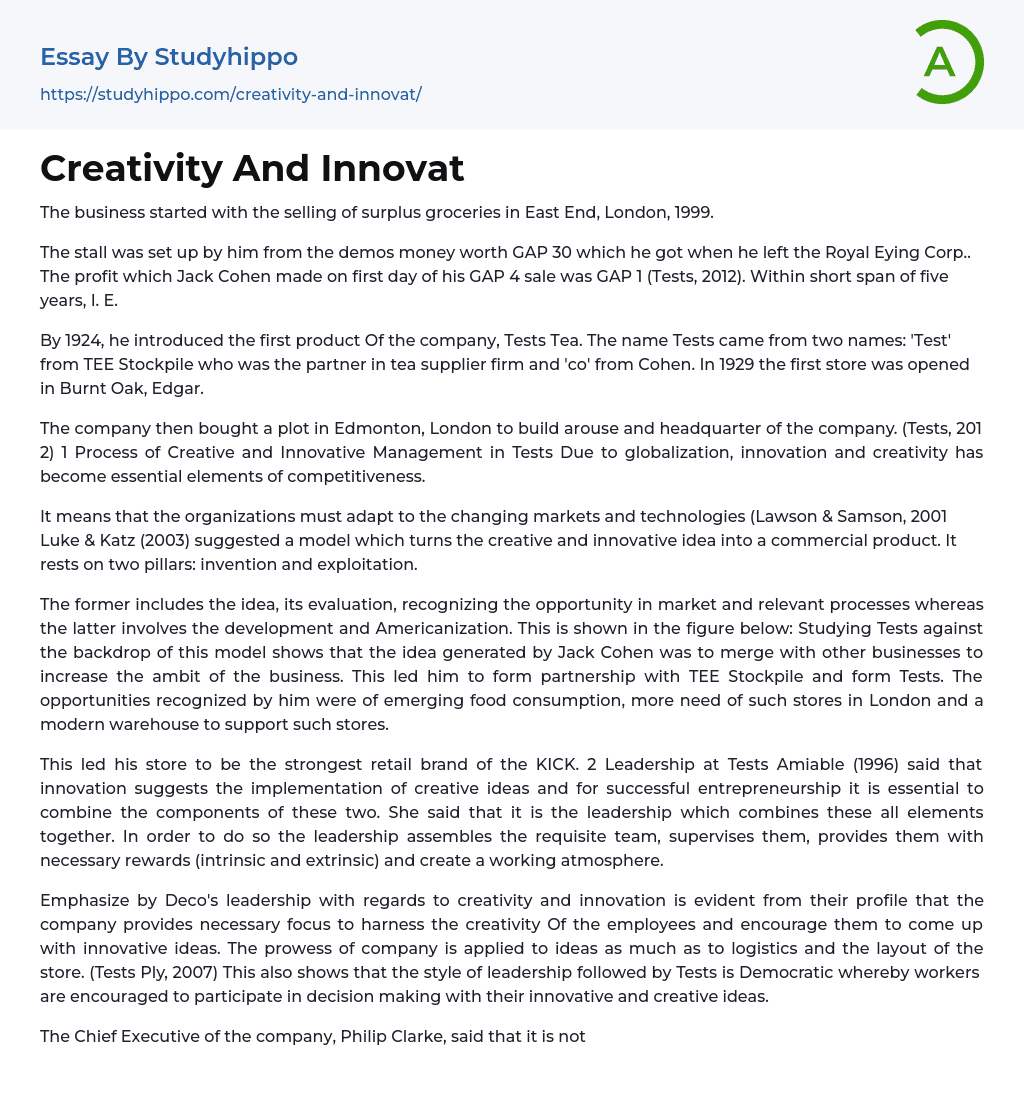In 1999, Jack Cohen started a business in East End, London selling surplus groceries. He used the GAP 30 demo money he received when leaving the Royal Eying Corp. to set up a stall. On the first day of his GAP 4 sale, he made a profit of GAP 1. Within five years, he introduced the first product of the company called Tests Tea in 1924. The name Tests came from TEE Stockpile, who was the partner in the tea supplier firm, and Cohen. In 1929, the first store was opened in Burnt Oak, Edgar. The company later purchased a plot in Edmonton, London, to build their headquarters.
Due to globalization, innovation and creativity have become essential elements of competitiveness for organizations. As such, they must adapt to changing markets and technologies. According to Luke & Katz (2003), a model exists that turns creative and innovative ide
...as into commercial products - it rests on two pillars: invention and exploitation. The former includes the idea and its evaluation, recognizing opportunities in the market, and relevant processes; whereas the latter involves development and Americanization. (Lawson & Samson, 2001).The figure below shows the idea generated by Jack Cohen to merge with other businesses in order to increase the range of the business, as demonstrated by studying Tests against this model. This led to his partnership with TEE Stockpile and the formation of Tests, with the recognition of opportunities in emerging food consumption, increased demand for such stores in London, and the need for a modern warehouse to support these stores. As a result, Tests became the strongest retail brand of KICK.
According to Amiable (1996), successful entrepreneurship require
the implementation of creative ideas and combining all essential components. This is accomplished by leadership through assembling the necessary team, supervising them, providing intrinsic and extrinsic rewards, and creating a productive work environment. Deco's leadership emphasizes creativity and innovation, as evident from their profile, by encouraging employees to harness their creativity and come up with innovative ideas. The company applies prowess to logistics, store layout, and ideas alike.According to Tests Ply (2007), the company's leadership style is democratic, allowing workers to participate in decision-making with their innovative and creative ideas. The Chief Executive, Philip Clarke, believes that innovation can come from any level of the hierarchy, and strives to ensure that all ideas are heard regardless of the position in the company. Tests' vision is to be a highly valued global business, not only by providing excellent service to customers but also by benefiting the communities and shareholders it serves. The company aims to remain constantly innovative and creative to sustain global growth (Tests, 2012). The mission of Tests is to become the largest retailer in LIKE and the top international retailer, with over 5,000 stores worldwide and more than 500,000 employees in fourteen countries. The company's values statement emphasizes the importance of creating a trusting and respectful workplace that motivates staff to deliver exceptional customer service, ultimately resulting in great customer satisfaction. By living up to these values, Tests creates a great working environment while delivering exceptional service to its customers.Not only do we have our own Customer Promises, but we also operate in various regions such as the UK, Europe, SIS, and Asia. In terms of trading profits, international profits (excluding the UK)
saw a rise of 18%, compensating for decreased profits in the UK. Due to this performance, we developed new ideas such as investing in break-even points in the US, exiting the Japanese market after eight years, creating a leasehold hypermarket in China, and implementing price drops in KICK to move towards cost leadership ("The Big Price Drop"). Despite potential risks, our innovations have resulted in being the largest online grocery retailer in the world with more than 7500 products on our website, Tests Direct. Our banking branch, Tests Bank, has generated a business of GAP 1 billion with GAP 168 million in profits and we saw a significant increase in sales, from GAP 67 million in 2011 to GAP 72 billion in 2012. (Tests, 2012)The company invested GAP 30 million in its training academy (Tests, 2012) but faces stiff competition on prices from rivals such as USDA and is at risk of self-cannibalism due to rapid expansion with multiple stores in London alone. The global expansion also means reliance on suppliers, and in certain countries, this dependence could enhance the bargaining power of suppliers and negatively impact profitability (Tests, 2011). In terms of change models, Tests can use the IDEAL model with its five steps: initiating, diagnosis, establishing, acting, and learning. Initiating involves laying down groundwork such as comparing prices with competitors like Cost Cutter and USDA. Diagnosing entails analyzing the company's position and setting goals to bridge the gap in cost leadership. Establishing involves planning how to achieve the goal, such as establishing a team to review competitor prices and identify regular items for price decreases.
- Aesthetics essays
- Art History essays
- Artist essays
- ballet essays
- Body Art essays
- Color essays
- Concert Review essays
- Creativity essays
- Cultural Anthropology essays
- Ethnography essays
- Harlem Renaissance essays
- Heritage essays
- Modernism essays
- Mona Lisa essays
- Pastoral essays
- Postmodernism essays
- Realism essays
- Symbolism essays
- Theatre essays
- Visual Arts essays
- Voice essays
- Work of art essays
- Automobile essays
- Bus essays
- Civil engineering essays
- Cycling essays
- Electric Car essays
- Genetic Engineering essays
- Hybrid essays
- Innovation essays
- Internal Combustion Engine essays
- Invention essays
- Mechanical Engineering essays
- Mechanics essays
- Software Engineering essays
- Telephone essays




